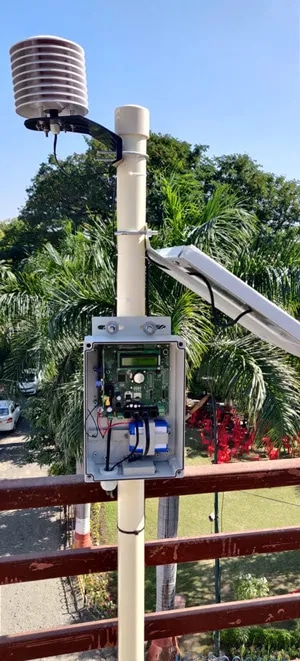Indian Cities Invest in Low-Cost Air Quality Sensors

 Why you can trust us
Why you can trust us
Founded in 2005 as an Ohio-based environmental newspaper, EcoWatch is a digital platform dedicated to publishing quality, science-based content on environmental issues, causes, and solutions.
By Deepa Padmanaban
In 2019, the Indian government established the National Clean Air Programme for nonattainment cities (cities that did not meet the National Ambient Air Quality Standards). The program aimed to develop clean air action plans to reduce particulate matter (PM2.5) pollution by 20% to 30% by 2024. So far, this effort has been largely ineffective.
The program’s inefficiency is partly due to a critical shortage of government air quality monitoring stations. Experts estimate that India needs 1,600 to 4,000 monitors. However, there are just 883 monitoring stations for assessing long-term air quality trends and 261 Continuous Ambient Air Quality Monitoring Stations, also known as Reference Grade Monitors (RGMs), that report the daily air quality index across the country. The discrepancy has resulted in gaps in data and underinformed mitigation approaches.
In 2021, the Commission for Air Quality Management, an agency that manages air quality in Delhi and the surrounding areas, recommended the use of low-cost sensors (LCSs) to address this discrepancy, but approval is pending because of misgivings about the accuracy and reliability of these sensors.
To test the precision and accuracy of low-cost PM2.5 sensors, scientists from the Indian Institute of Technology (IIT) Kanpur installed 40 sensors next to government RGMs in Mumbai. The Maharashtra Pollution Control Board conducted this pilot project from November 2020 to July 2021.
S. N. Tripathi, a study coauthor and professor of civil engineering at IIT Kanpur, said, “Our study shows that PM2.5 LCSs have high precision and can achieve an accuracy of 80% to 90% compared to the RGMs.” Low-cost sensors are more maneuverable than RGMs, he notes, which allows them to have a higher temporal resolution and provide more specific geographic data.
However, the LCSs “need to be calibrated against RGMs before use,” said Pratima Singh, an air pollution scientist at the Centre for Study of Science, Technology and Policy (CSTEP), Bengaluru. “There has to be a standard framework on using these devices.”
CSTEP assessed the performance of various PM2.5 LCSs by comparing them with the RGMs. They found that LCSs match the government sensors qualitatively, but not quantitatively.
Working With Local Clean Air Guides
Tripathi said that cities are more inclined toward using LCSs after his team’s cautiously encouraging results. Studies are currently underway to use LCSs (in addition to RGMs) to assess air quality in Chennai, Jaipur, Guwahati, and other urban areas. “We have interesting observations that we would not get from the limited number of government monitors,” he added.
For example, Smart Cities Mission, a federal initiative to promote sustainable development in cities, is using LCSs to quantify pollution at local levels. In 2021, Smart Cities Mission partnered with John Snow India, a health care consultant, to identify air pollution hot spots in Indore, a city of about 2 million in the state of Madhya Pradesh.
As part of the initiative, 20 community social workers were engaged as “clean air guides” and were trained to use and interpret LCS data. Damodar Bachani, deputy project director at John Snow India, said, “The idea of using social workers was to educate people, particularly the urban poor, who don’t know much about air pollution, so that they can take action to reduce it.”
Data from sensors installed at 19 sites in Indore showed that sources of pollution varied from place to place. The main source of pollution was vehicles in commercial areas, manufacturing waste in industrial areas, and the burning of biofuels in residential areas.

“This community-based approach shows that you just can’t take common decisions for the entire city, as sources vary, and therefore strategies to reduce pollution will also vary,” said Bachani.
For example, in places where the pollution levels were high because of traffic congestion, the city initiated a campaign called “Red Light On, Engine Off.” The campaign urged people to switch off their vehicles while waiting at traffic lights. The campaign witnessed a 20-point reduction in emissions.
Education efforts by clean air guides also influenced behavior in the community. People shifted to wet sweeping from dry sweeping, walking short distances rather than using transport, and planting more trees. Clean air guides also reported reductions in the burning of waste and the use of biofuels in slums and eateries.
Tripathi said the next steps are to test LCSs in rural areas to better understand rural air quality and the relationship between the sources of pollution in rural and urban areas. Most rural areas lack government-run monitoring stations.
Identifying Local Hot Spots
Pilot studies conducted with LCSs in rural parts of the Indo-Gangetic plain already have shown that PM2.5 levels are quite comparable in different settlements across the region, irrespective of the settlement type — village, town, city.
Saumya Singh, a postdoctoral researcher at the University of California, Berkeley and lead author of the new study, said, “Low-cost sensors are helping us understand the urban-rural gradient. These results suggest that we need additional observations in rural settings about source dynamics and concentrations of PM2.5.”
Pratima Singh agreed that low-cost sensors have their advantages, and CSTEP has installed a network of LCSs in Bengaluru, Punjab, and Delhi to study different aspects of air pollution.
“Low-cost sensors have a high temporal resolution that helps identify hot spots at local levels, which RGMs cannot because of their incapability to be moved around,” she said.
Reposted with permission from Eos.
Subscribe to get exclusive updates in our daily newsletter!
By signing up, you agree to the Terms of Use and Privacy Policy & to receive electronic communications from EcoWatch Media Group, which may include marketing promotions, advertisements and sponsored content.

 233k
233k  41k
41k  Subscribe
Subscribe 



